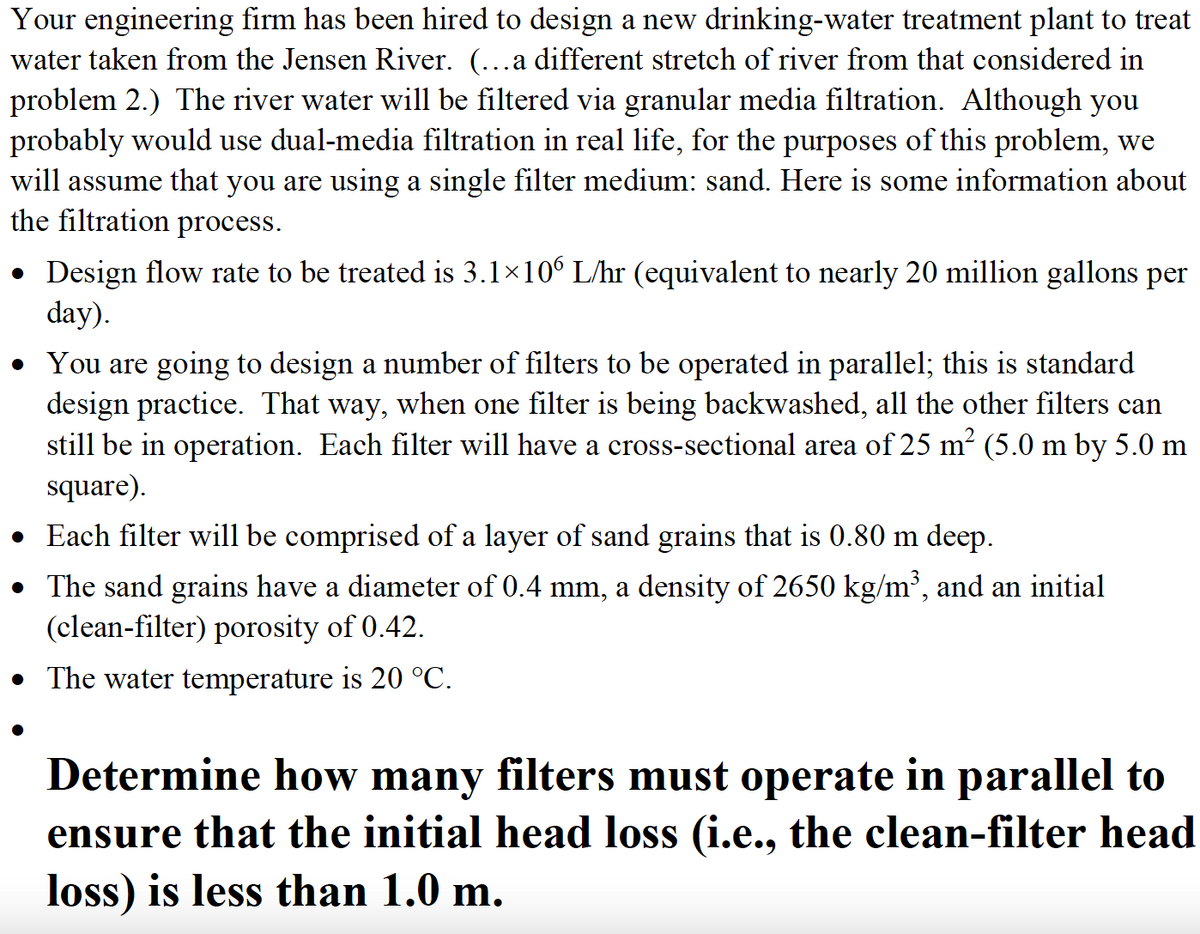Your engineering firm has been hired to design a new drinking-water treatment plant to treat water taken from the Jensen River. (...a different stretch of river from that considered in problem 2.) The river water will be filtered via granular media filtration. Although you probably would use dual-media filtration in real life, for the purposes of this problem, we will assume that you are using a single filter medium: sand. Here is some information about the filtration process. • Design flow rate to be treated is 3.1×10° L/hr (equivalent to nearly 20 million gallons per day). • You are going to design a number of filters to be operated in parallel; this is standard design practice. That way, when one filter is being backwashed, all the other filters can still be in operation. Each filter will have a cross-sectional area of 25 m2 (5.0 m by 5.0 m square). • Each filter will be comprised of a layer of sand grains that is 0.80 m deep. • The sand grains have a diameter of 0.4 mm, a density of 2650 kg/m³, and an initial (clean-filter) porosity of 0.42. • The water temperature is 20 °C. Determine how many filters must operate in parallel to ensure that the initial head loss (i.e., the clean-filter head loss) is less than 1.0 m.
Your engineering firm has been hired to design a new drinking-water treatment plant to treat water taken from the Jensen River. (...a different stretch of river from that considered in problem 2.) The river water will be filtered via granular media filtration. Although you probably would use dual-media filtration in real life, for the purposes of this problem, we will assume that you are using a single filter medium: sand. Here is some information about the filtration process. • Design flow rate to be treated is 3.1×10° L/hr (equivalent to nearly 20 million gallons per day). • You are going to design a number of filters to be operated in parallel; this is standard design practice. That way, when one filter is being backwashed, all the other filters can still be in operation. Each filter will have a cross-sectional area of 25 m2 (5.0 m by 5.0 m square). • Each filter will be comprised of a layer of sand grains that is 0.80 m deep. • The sand grains have a diameter of 0.4 mm, a density of 2650 kg/m³, and an initial (clean-filter) porosity of 0.42. • The water temperature is 20 °C. Determine how many filters must operate in parallel to ensure that the initial head loss (i.e., the clean-filter head loss) is less than 1.0 m.
Chapter2: Loads On Structures
Section: Chapter Questions
Problem 1P
Related questions
Question

Transcribed Image Text:Your engineering firm has been hired to design a new drinking-water treatment plant to treat
water taken from the Jensen River. (...a different stretch of river from that considered in
problem 2.) The river water will be filtered via granular media filtration. Although you
probably would use dual-media filtration in real life, for the purposes of this problem, we
will assume that you are using a single filter medium: sand. Here is some information about
the filtration process.
• Design flow rate to be treated is 3.1×10° L/hr (equivalent to nearly 20 million gallons per
day).
• You are going to design a number of filters to be operated in parallel; this is standard
design practice. That way, when one filter is being backwashed, all the other filters can
still be in operation. Each filter will have a cross-sectional area of 25 m2 (5.0 m by 5.0 m
square).
• Each filter will be comprised of a layer of sand grains that is 0.80 m deep.
• The sand grains have a diameter of 0.4 mm, a density of 2650 kg/m³, and an initial
(clean-filter) porosity of 0.42.
• The water temperature is 20 °C.
Determine how many filters must operate in parallel to
ensure that the initial head loss (i.e., the clean-filter head
loss) is less than 1.0 m.
Expert Solution
This question has been solved!
Explore an expertly crafted, step-by-step solution for a thorough understanding of key concepts.
Step by step
Solved in 2 steps

Recommended textbooks for you


Structural Analysis (10th Edition)
Civil Engineering
ISBN:
9780134610672
Author:
Russell C. Hibbeler
Publisher:
PEARSON

Principles of Foundation Engineering (MindTap Cou…
Civil Engineering
ISBN:
9781337705028
Author:
Braja M. Das, Nagaratnam Sivakugan
Publisher:
Cengage Learning


Structural Analysis (10th Edition)
Civil Engineering
ISBN:
9780134610672
Author:
Russell C. Hibbeler
Publisher:
PEARSON

Principles of Foundation Engineering (MindTap Cou…
Civil Engineering
ISBN:
9781337705028
Author:
Braja M. Das, Nagaratnam Sivakugan
Publisher:
Cengage Learning

Fundamentals of Structural Analysis
Civil Engineering
ISBN:
9780073398006
Author:
Kenneth M. Leet Emeritus, Chia-Ming Uang, Joel Lanning
Publisher:
McGraw-Hill Education


Traffic and Highway Engineering
Civil Engineering
ISBN:
9781305156241
Author:
Garber, Nicholas J.
Publisher:
Cengage Learning